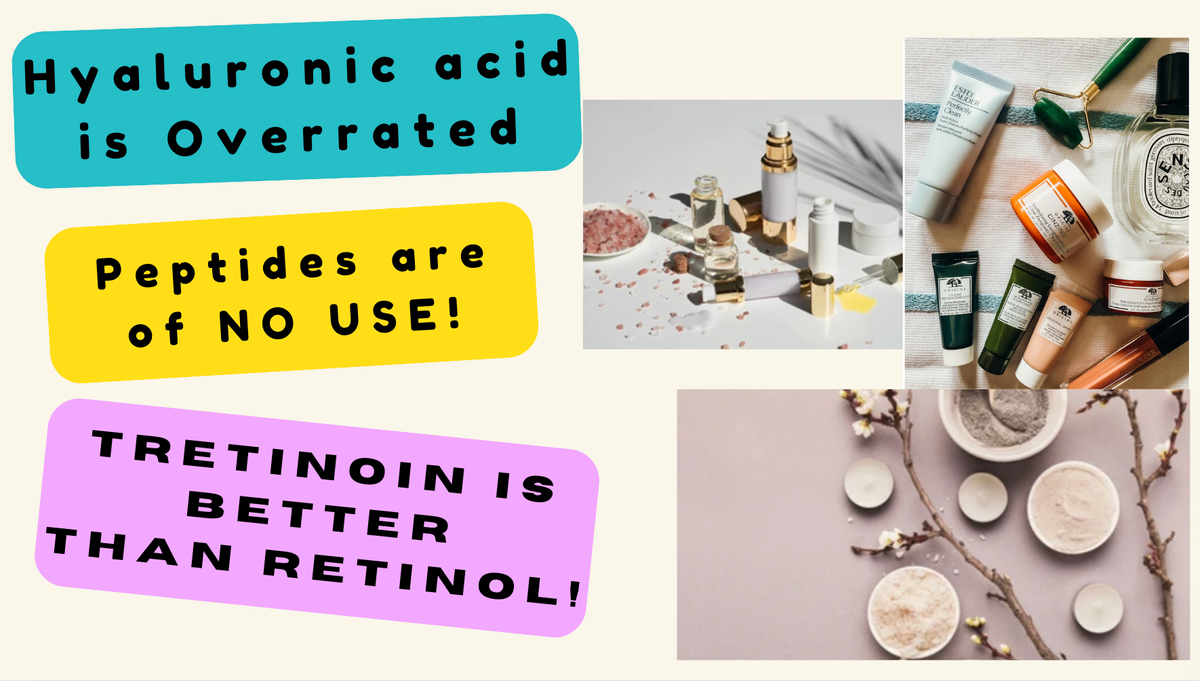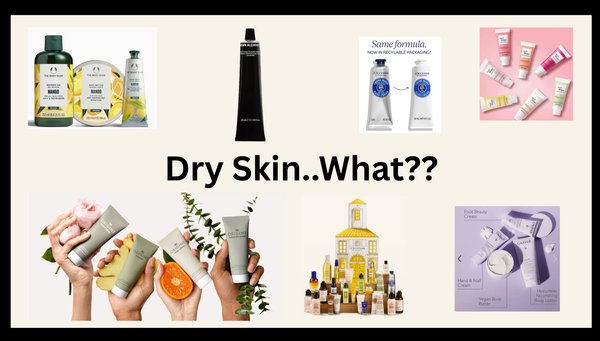Which skincare ingredients actually work? (According to Science)

In the wide world of skincare products, there are many ingredients claiming to do different things, like moisturizing or fighting aging. But what's the real science behind them? In this blog post, we'll explore the important science behind some key skincare ingredients in simple words, supported by research and references.
For example, in the above ad, they have claimed that this cream contains different ingredients that perform different functions backed by science! I read different scientific research papers to verify each claim. So, let's delve into this in detail.
1. Ceramides
Ceramides are major lipid constituents of lamellar sheets present in the outermost layer of the dermis (skin). Ceramides maintain the water-permeable barrier of the skin. In most cases of skin disorders, this water permeability barrier of the skin is damaged, which can result in excessive loss of water from the skin, leaving the skin dry. Creams containing lipids identical to those in the skin (such as ceramides), improve disturbed skin conditions such as dermatitis and eczema. (Coderch et al., 2003)
2. Chrysin:
Chrysin belongs to the class of chemicals called flavonoids. It occurs naturally in various plants and honey-bee-glue. It has many anti-inflammatory and antioxidant properties. It protects the skin from harmful effects of UV radiation by neutralizing Reactive Oxygen Species, that cause cutaneous damage and skin cancer. Chrysin also shows therapeutic advantages in acne, psoriasis, and wound healing. It is used in anti-aging skin cosmetics because of its ability to reduce dark circles under the eyes (Islam et al., 2022).
3. Caffeine:
Accumulation of molecular damage due to reactive oxygen species (ROS) causes skin aging, leading to skin senescence. Senescence is the phenomenon in which cells lose their power of division and growth. Different studies have shown that caffeine protects the skin from oxidative stress-induced senescence and improves the skin texture. Caffeine also plays an important role in protecting the skin cells from oncogenic (cancer-related) stress. (Li et al., 2018).
Coffee byproducts (mainly caffeine) from (used) coffee grounds are widely used as an alternative to vegetable oil in the cosmetic industry due to their high content of unsaturated fatty acids. Deficiency of ceramides, cholesterol, essential fatty acids, and triglycerides can result in significant transepidermal water loss (TEWL) and skin dryness. Caffeine and other unsaturated fatty acids improve skin hydration, maintain a healthy skin barrier, and keep the skin soft. (Rodrigues et al., 2023)
4. Peptides:
There are many articles available on the internet that emphasize the importance of peptides in skincare products, claiming that they lead to firmer and younger-looking skin, with fewer breakouts. However, all these articles are written by beauty bloggers, and not backed by science.
Peptides are fragments of protein molecules and are polar (i.e. they have positive and negative charges). Therefore, when applied to the skin, they cannot penetrate the skin due to the presence of the skin barrier (consisting of lipids, that are non-polar).
Anti-aging peptides do have some benefits for the skin:
Bioactive Peptides: They repair and renew the skin (during wound healing and aging), stimulate collagen production and cell proliferation (rapid cell division), and reduce melanogenesis (that reduces pigmentation).
Antioxidant Peptides: They remove Reactive Oxygen Species (ROS) from the body, reducing the risk of cancer.
Antimicrobial Peptides: They kill harmful bacteria.
But here is the catch! Peptides added to the skincare products cannot penetrate the skin without physical enhancers like microneedles and Iontophoresis (i.e., passing weak electric current through the skin). Excessive microneedling and Iontophoresis diminish the natural elasticity of the skin cells over time. So, in the long term, they do more harm than good. (Veiga et al., 2023)
Naturally occurring peptides are highly soluble, fragile, expensive, and interfere with normal body function by absorbing into blood circulation when applied to the skin. However, synthetic peptides can be modified to target specific problems for the skin, but their stability and non-toxicity cannot be fully guaranteed. (Lintner & Peschard, 2000)
5. Collagen:
Collagen is the most abundant structural protein present in our skin. Its continuous exposure to UV radiation leads to premature aging. This effect can be reversed by applying collagen directly onto the skin. Percutaneous collagen induction also offers regenerative therapy to improve skin appearance and quality and to improve or even prevent scarring (Aust et al., 2010).
6. Avocado Oil:
Oil extracted from avocado seeds contains starch, water, lipids, protein, phytochemicals, antinutrients, vitamins, and minerals. In a study carried out by Werman et al., 1991, when avocado oil was given to rats orally, it increased the content of soluble collagen in the skin. Collagen has various benefits for our skin as discussed above. However, the seeds of avocados are not edible for humans.
Avocado oil (obtained from avocado peel) has a Sun Protection Factor (SPF) of 6-16. It also nourishes the skin and makes it silky and smooth. Avocado oil is also used in various cosmetics because of its antibacterial and antifungal activities, to increase their shelf life. (Charles et al., 2022)
Avocado oil has some antiaging properties as well. In a study carried out by Naeimifar et al., 2020, an antiwrinkle cream containing Saffron extract and Avocado Oil increased skin elasticity and reduced the appearance of wrinkles.
7. Hyaluronic acid:
Hyaluronic acid (or HA) is naturally synthesized by our body, 50% of which is present in the skin. Human skin aging is the result of 2 independent processes: Intrinsic aging and Extrinsic aging. Intrinsic or Innate aging is an unpreventable process that affects the skin just like it affects all internal organs. It is influenced by hormonal changes with age (i.e., decreased sex hormone production). Extrinsic aging (or Photoaging) is the result of exposure to ultraviolet radiation.
Both types of aging have the same ultimate effect on the skin: collagen degradation, dryness, loss of elasticity, epidermal atrophy, and wrinkling. HA has a unique capacity to bind and retain water molecules. That is how it keeps the skin looking young and fresh.
HA also facilitates skin cell proliferation (rapid cell division), especially at the site of a wound. If enough HA is present at the wound site, the skin heals fully without leaving a scar.
However, an important thing to note is that our skin can only benefit from HA produced by our own body. HA received by the skin from external sources (like skincare products) is cleared from the dermis (middle and internal layers of the skin) and rapidly degraded! (Papakonstantinou, E. et al., 2012)
Fun Fact: In World War 1, Hyaluronic acid (also known as the Regenerator) was widely used by the USSR in bandages to prevent the soldiers from frostbite. At that time, the human umbilical cord was the major source of HA for industrial use. Today, HA is widely used in the field of ophthalmology (in synthetic lenses, and artificial retinas to treat retinal detachment, etc.). It is also injected into the joints to treat Arthritis. (Selyanin et al., 2018)
8. Squalene:
Squalene is a polyunsaturated hydrocarbon. It is a major component of human skin and protects it from ultraviolet radiation and sun damage. It is used in skincare to hydrate and soothe the skin. It is highly effective in repairing the damaged skin barrier in dry and damaged skin.
Fun Fact: Squalene is abundantly found in different fish oils, especially shark liver oil, and vegetable oils, and is widely used in health and pharmaceutical industries for its anticancer, antioxidant, drug carrier, detoxification, skin hydration, and emollient activities. (Kim & Karadeniz., 2012)
9. Retinol and Retinoic acid:
Retinol is also known as Vitamin A. Retinol is a precursor of Retinoic acid. Retinoic acid is also known as Tretinoin. Both are incredible antiaging ingredients. However, Retinoic acid is way more effective than Retinol.
They increase the thickness and elasticity of the skin cells, reducing the appearance of wrinkles. They also stimulate the proliferation (rapid division) of skin cells. As a result, the young skin cells replace the older skin cells, resulting in younger and healthier-looking skin on the surface.
Prominent differences can be observed after 1 week of using retinoids while 4 weeks of continuous use can reduce wrinkles by 60% (even in people over the age of 75+ years). These ingredients also upregulate the expression of certain genes that produce collagen. (Kong R et al., 2016 and Shao Y et al., 2017)
10. Vitamin C
Vitamin C is also known as Ascorbic Acid. Women’s skin has significantly low collagen as compared to men’s. Therefore, they are more prone to showing signs of aging.
Vitamin C is a non-enzymatic antioxidant and can eliminate Reactive Oxygen Species (ROS) (created as a result of Sun and UV exposure) without leaving any harmful effects.
The topical application of Vitamin C on the skin has many positive effects, such as skin whitening, elasticity enhancement, and wrinkle reduction. It also increases skin gloss.
Visible results can be seen after 1 week of using Vitamin C. After 4 weeks, skin elasticity increases by 9% while the appearance of wrinkles improves by 12%. (Ahmed et al., 2020)
References
- Ahmed, I. A., Mikail, M. A., Zamakshshari, N., & Abdullah, A. S. H. (2020). Natural anti-aging skincare: role and potential. Biogerontology, 21, 293-310.
- Aust, M. C., Reimers, K., Gohritz, A., Jahn, S., Stahl, F., Repenning, C., ... & Vogt, P. M. (2010). Percutaneous collagen induction. Scarless skin rejuvenation: fact or fiction?. Clinical and Experimental Dermatology: Clinical dermatology, 35(4), 437-439
- Charles, A. C., Dadmohammadi, Y., & Abbaspourrad, A. (2022). Food and cosmetic applications of the avocado seed: a review. Food & Function, 13(13), 6894-6901.
- Coderch, L., López, O., de la Maza, A., & Parra, J. L. (2003). Ceramides and skin function. American journal of clinical dermatology, 4(2), 107-129.
- Islam, M. M., Nagaraja, S., Hafsa, N. E., Meravanige, G., Asdaq, S. M. B., & Anwer, M. K. (2022). Polyphenol chrysin for management of skin disorders: Current status and future opportunities. Journal of King Saud University-Science, 102026.
- Kim, S. K., & Karadeniz, F. (2012). Biological importance and applications of squalene and squalane. Advances in food and nutrition research, 65, 223-233.
- Kong, Rong, et al. "A comparative study of the effects of retinol and retinoic acid on histological, molecular, and clinical properties of human skin." Journal of cosmetic dermatology 15.1 (2016): 49-57.
- Lintner, & Peschard. (2000). Biologically active peptides: from a laboratory bench curiosity to a functional skin care product. International journal of cosmetic science, 22(3), 207-218.
- Naeimifar, A., Ahmad Nasrollahi, S., Samadi, A., Talari, R., Sajad Ale‐nabi, S., Massoud Hossini, A., & Firooz, A. (2020). Preparation and evaluation of anti‐wrinkle cream containing saffron extract and avocado oil. Journal of cosmetic dermatology, 19(9),.
- Papakonstantinou, E., Roth, M., & Karakiulakis, G. (2012). Hyaluronic acid: A key molecule in skin aging. Dermato-endocrinology, 4(3), 253-258.
- Rodrigues, R., Oliveira, M. B. P. P., & Alves, R. C. (2023). Chlorogenic acids and caffeine from coffee by-products: A review on skincare applications. Cosmetics, 10(1), 12.
- Shao, Yuan, et al. "Molecular basis of retinol anti‐ageing properties in naturally aged human skin in vivo." International journal of cosmetic science 39.1 (2017): 56-65.
- Veiga, E., Ferreira, L., Correia, M., Pires, P. C., Hameed, H., Araújo, A. R., ... & Paiva-Santos, A. C. (2023). Anti-aging peptides for advanced skincare: focus on nanodelivery systems. Journal of Drug Delivery Science and Technology, 105087.
- Werman, M. J., Mokady, S., Ntmni, M. E., & Neeman, I. (1991). The effect of various avocado oils on skin collagen metabolism. Connective tissue research, 26(1-2), 1-10.





